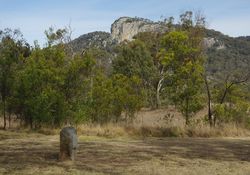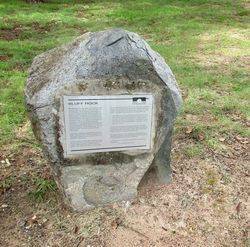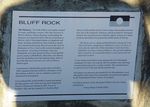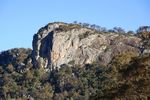
Bluff Rock MassacrePrint Page 
The monument commemorates Aboriginals killed in this area during European settlement of the area
The Bluff Rock Massacre remains clouded by many conflicting versions. One time Overseer at Bolivia Station, Thomas Keating, in describing the massacre as it had been told him by an old man at Bolivia, told of Aboriginal attacks on shepherds and sheep. Keating outlined how men on Bolivia Station were mustered and armed, then set out on the track of Aborigines to Pyes Creek on the western boundary of the property.
According to Keating's story the Aboriginals were then attacked at Pyes Creek and they fled across country to Bluff Rock, where they were thrown from the top, killing most and injuring many. None of that tribe, which survived, were ever seen on Bolivia Station again.
Location
| Address: | New England Highway, Bluff Rock, Tenterfield, 2372 |
|---|---|
| State: | NSW |
| Area: | AUS |
| GPS Coordinates: | Lat: -29.154587 Long: 152.001902 Note: GPS Coordinates are approximate. |
Details
| Monument Type: | Monument |
|---|---|
| Monument Theme: | Conflict |
| Sub-Theme: | Frontier |
| Actual Event Start Date: | 17-October-1844 |
| Actual Event End Date: | 17-October-1844 |
| Link: | https://c21ch.newcastle.edu.au/colo… |
Dedication
Bluff Rock
The Massacre. The truth of this event remains clouded by many conflicting versions. One time Overseer at Bolivia Station, Thomas Keating, in describing the massacre as it had been told to him by an old man at Bolivia, told of Aboriginal attacks on shepherds and sheep. Keating outlined how men at Bolivia station were mustered and armed, then set out on the track of Aborigines to Pyes Creek on the western boundary of the property. According to Keating`s story, the aboriginals were then attacked at Pyes Creek and fled across country to Bluff Rock, where they were thrown from the top killing most and injuring many. None of that tribe survived were ever seen on Bolivia Staion again.
Commissioner MacDonald reported that in October 1844 a shepherd had been killed by Aborigines on the Irby Station at Bolivia, but no retaliatory action was mentioned in his dispatch. It was Edward Irby and his brother Leonard who named the huge granite rock whilst moving from Tenterfield Station to Deepwater Station in 1842. It was St. Swithin`s Day and they named it St. Swithins Bluff.
However, Edward Irby himself, when writing of the incident, describes how one of his shepherds, Robinson, had been killed by Aborigines and how four men had set out to find the culprits. In these few simple words he described in his journal the terrible deeds of that day.
"The blacks saw us coming and hid themselves among the rocks. One in his haste, dropped poor Robinson`s coat so we knew we were onto the right tribe. If they had taken to their heels they might have got away, instead of doing so, they got their fighting men to attack us. So we punished them severely and proved our superiority to them."
A very strong oral tradition exists amongst the local Aboriginal community of a baby surviving the fall in its mothers arms and being rescued and brought up by a nearby resident. The unmarked grove is said to be East of the rock and the present road.
The plaque was prepared and installed by the Moombahlene Local Aboriginal Land Council from information researched and supplied by the Tenterfield & District Visitors Association.
Unveiled in memory of the Aboriginals killed in this area during settlement by George Binge & Bertha Daley








